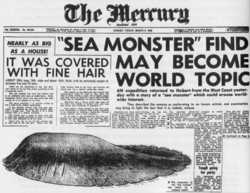
Tasmanian Globster
Encyclopedia

Tasmania
Tasmania is an Australian island and state. It is south of the continent, separated by Bass Strait. The state includes the island of Tasmania—the 26th largest island in the world—and the surrounding islands. The state has a population of 507,626 , of whom almost half reside in the greater Hobart...
, in August 1960. It measured 20 ft (6.1 m) by 18 ft (5.5 m) and was estimated to weigh between 5 and 10 ton
Ton
The ton is a unit of measure. It has a long history and has acquired a number of meanings and uses over the years. It is used principally as a unit of weight, and as a unit of volume. It can also be used as a measure of energy, for truck classification, or as a colloquial term.It is derived from...
s. The mass lacked eyes and in place of a mouth, had "soft, tusk-like protuberances". It had a spine, six soft, fleshy 'arms' and stiff, white bristles covering its body.
The carcass was identified as a whale
Whale
Whale is the common name for various marine mammals of the order Cetacea. The term whale sometimes refers to all cetaceans, but more often it excludes dolphins and porpoises, which belong to suborder Odontoceti . This suborder also includes the sperm whale, killer whale, pilot whale, and beluga...
by L.E. Wall in the journal Tasmanian Naturalist in 1981, and a later electron microscopy analysis of the collagen fibers
Collagen
Collagen is a group of naturally occurring proteins found in animals, especially in the flesh and connective tissues of mammals. It is the main component of connective tissue, and is the most abundant protein in mammals, making up about 25% to 35% of the whole-body protein content...
confirmed this.
The term globster
Globster
A globster, or blob, is an unidentified organic mass that washes up on the shoreline of an ocean or other body of water. The term was coined by Ivan T. Sanderson in 1962 to describe the Tasmanian carcass of 1960, which was said to have "no visible eyes, no defined head, and no apparent bone...
was coined in 1962 by Ivan T. Sanderson
Ivan T. Sanderson
Ivan Terence Sanderson was a naturalist and writer born in Edinburgh, Scotland, who became a naturalized citizen of the United States. Sanderson is remembered for his nature writing and his interest in cryptozoology and paranormal subjects.-Biography:Born in Scotland, Sanderson traveled widely in...
to describe this carcass and the name Sea Santa coined by another journalist in the same year.

